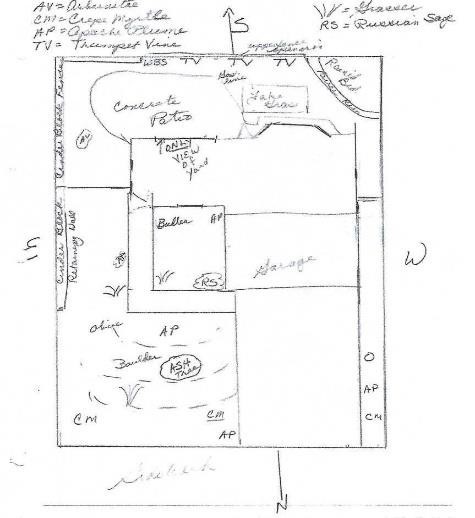Garden Planning 101 – Winter Preparation

(photo: K. Shadock)
by Kate Shadock, SEMG 2018
Garden planning for many of us, is often more about fixing the planting mistakes of the developers or previous owners than creating an oasis from scratch. It can feel like an overwhelming task; especially if you are new to the area and not familiar with the challenges of our soil and climate. Those challenges are a great reason to become a Master Gardener.
Tools to Get Started: Tracing paper, a ruler, pencil, eraser, and a plat map of your property. That will be part of the closing papers if you bought the home. If you are renting; you are probably limited to container gardening – which can be even more fun. Enlarge the plat plan and to the point the plot outline takes up most of an 8.5 X 11 piece of paper. Trace the outline with a marker to make it visible though the tracing paper.
Where Are You Starting? Many gardening experts suggest planning your garden in the winter. It’s nicer to be inside and warm with a sketch than outside in the dirt when it’s 33 degrees. Bare spots in the garden are even more pronounced in the wintertime. It’s also easier to see the overall health of deciduous shrubs and trees in the winter when the leaves are gone.
What is in Your Yard – Now? The names of the trees or shrubs aren’t critical for this first sketch – it matters more where they are, what’s next to them and if it’s a deciduous or an evergreen. Draw on your tracing paper what is in the garden today. On a sunny winter day, it’s helpful to wander around your garden, front and back, taking photos to help remind you what is there and how it looks in the winter months.
If you moved into your property in the middle of winter you won’t know, for sure, how big the plants can get. An example is Russian Sage. It might have been pruned to the ground and you don’t realize it will be 6’x6’ in July. If you have been through a growing season sketch the plants to scale at their full size.
What’s Not Working for You? It’s not uncommon for builders to hire a planting crew to ‘drop plants in the ground’ without considering the mature spread. That can translate into plants growing over the roof, into the stucco siding or falling onto sidewalks. Any plant that appears intrusive in the winter will likely be an endless pruning project in the summer. Maybe it’s a rose bed that hasn’t been maintained for years with lots of dead canes. Simply note, on your sketch, what needs to be done later.
What’s Missing? One of the hardest adjustments for me is the lack of color in both private and public landscapes from the end of October until mid-March. If that’s a need for you as well, consider which windows in your home give you the best view of the yard and/or the mountains. Make a note to add a splash of color outside those windows. Perhaps, from your prime windows, such as the kitchen or living room all you see is sand or gravel and no plantings. That would be a terrific place to start adding new vegetation – make a note on your sketch.
What’s Possible? Xeriscaping, Native Plants and Water Wise gardening are terms we learn living in the high desert. There is an amazing variety of perennials, grasses, shrubs, and trees that thrive in our climate. Now that you have your first sketch, it’s time to read up on what plants appeal to you and thrive here. Here are few suggestions, from my own bookcase, to get you started:
MONTH-BY-MONTH GARDENING Arizona, Nevada & New Mexico by Jacqueline A. Soule
NEW MEXICO GARDENER’S GUIDE By Judith Phillips
BEST PLANTS for New Mexico Gardens and Landscapes by Baker H. Morrow
DRY CLIMATE GARDENING by Ortho books
GROWING THE SOUTHWEST GARDEN by Judith Phillips
